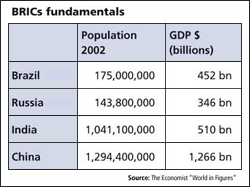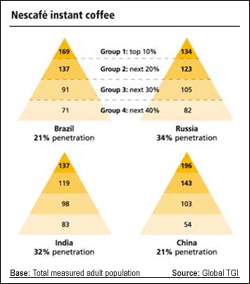Brand building in the BRICs
July 2006
The BRICs markets of Brazil, Russia, India and China are coming under increasing focus. Their unifying factors are their size - overall they represent 43% of the world population - and their potential. With economic growth rates perhaps double the level of the developed western economies, the numbers of consumers entering the market for branded consumer goods will continue to increase rapidly. International companies seeking to achieve growth with their global brands cannot afford to ignore them.

In particular, brand owners should seek to market to the 'Super Consumers' or the top 10% of each country's population. Their wealth generally makes them the first to try new products and brands. Once a brand has established a base among this group, uptake should spread into the mass market as the divide narrows.
This report from KMR, part of the
Kantar Group, uses research-based evidence to provide guidance for marketers. It draws on the TGI (Target Group Index) studies in each of the four markets, which between them survey 144,000 adults. It examines the similarities and differences between the BRICs, and suggests strategies for building successful brands in these huge and dynamic markets.
Topline FindingsUnderlying values and attitudesFor brand owners developing strategies to communicate to audiences in the BRICs, understanding the subtleties of cultures and value sets is vital. Mistakes made due to miscomprehension could be very costly. Exploration suggests some broad conclusions for the association of brands with certain values:
- Some values, generally conservative and unadventurous, are universal. Brand images related to these - for example family life - can be considered risk-free.
- Specific values shared among the BRICs countries but not by Americans or Europeans are mostly concerned with image in the face of the family or of society. Aspirations of success can be used positively in marketing, as the struggle for social ascension is considered to be a sign of a healthy society.
- Marketing based on divergent values may work well in some countries but be controversial and destructive in others. For example, Brazilians are concerned to look attractive to the opposite sex - but the leading beer brand that had great success with a campaign on this theme would not have been wise to use it in China.
- The widest divergences from international 'norms' exist in China and India. Particularly in their major cities, status is a key driver and brands that convey it can do well.
Indicator measuresAs well as social and demographic factors, the presence in homes of durable items often indicates economic development and potential. Attitudes to brands, marketing and advertising are also instructive:

- The highest proportion of young adults and the largest average household sizes are to be found in India.
- Levels of ownership of household durables vary, but for Chinese cities they reach 87% of European levels. They are growing fastest in India.
- Consumers in all the BRICs are keen to try new products (average over 60%) and, when persuaded about a brand's merits, will stay loyal (average over 70%).
- The 'Super Consumers' or the top 10% of each country's population in socio-economic status, are a key audience. They have above-average income and resources and possess a large proportion of all high-ticket items owned. They are also most likely to use international brands. TGI's Global SEL (Socio-Economic Levels) classification allows for targeting on this basis.
Strategies for successMany international brands have been active in pursuing the huge opportunities offered by the BRICs markets. Some of them have experienced great success: Coca Cola, Colgate, Pepsi and McDonalds among them. What strategies can be deployed?
- Category flooding, or putting multiple brands into the same sector at different price points, has proved successful. For example Unilever leads the Toilet Soap category in India with Liril, Dove, Lux and Lifebuoy, and in the Tea category in Russia with Lipton and Beseda.
- Another is localising the offer, in other words adapting the brand to fit local tastes. In China, Procter & Gamble has met success with Crest Salty Toothpaste (for whitening) as well as Tea Flavoured Crest Toothpaste (drinking tea is believed to eliminate bad breath). Haagen-Dazs in China produce Green Tea Ice Cream.
- Frito-Lay's Cheetos are 'cheese-less' in China, where its flavours include 'Peking duck'. The concept of balancing 'Yin' and 'Yang' is behind 'Cool Lemon Lays' potato chips, which combine lime and mint flavours into what is promoted as a cool refreshing taste for China's hot summer. In India Frito-Lay has created a snack brand called 'Kurkure' - which means crunchy in Hindi. These are similar to Cheetos but with Indian flavouring.
Historically, globalisation has been led by western brands, and the movement has depended on the spread of western values. But if it is to spread more deeply in the BRICs, brand owners must deal with the limits of western values.
Designing a branding strategy to meet the demands of each of the BRICs is a difficult task, particularly when the same products have to be sold in western markets. The challenges that confront marketers in attempting to extend globalization in this way are enormous. But so are the potential rewards.